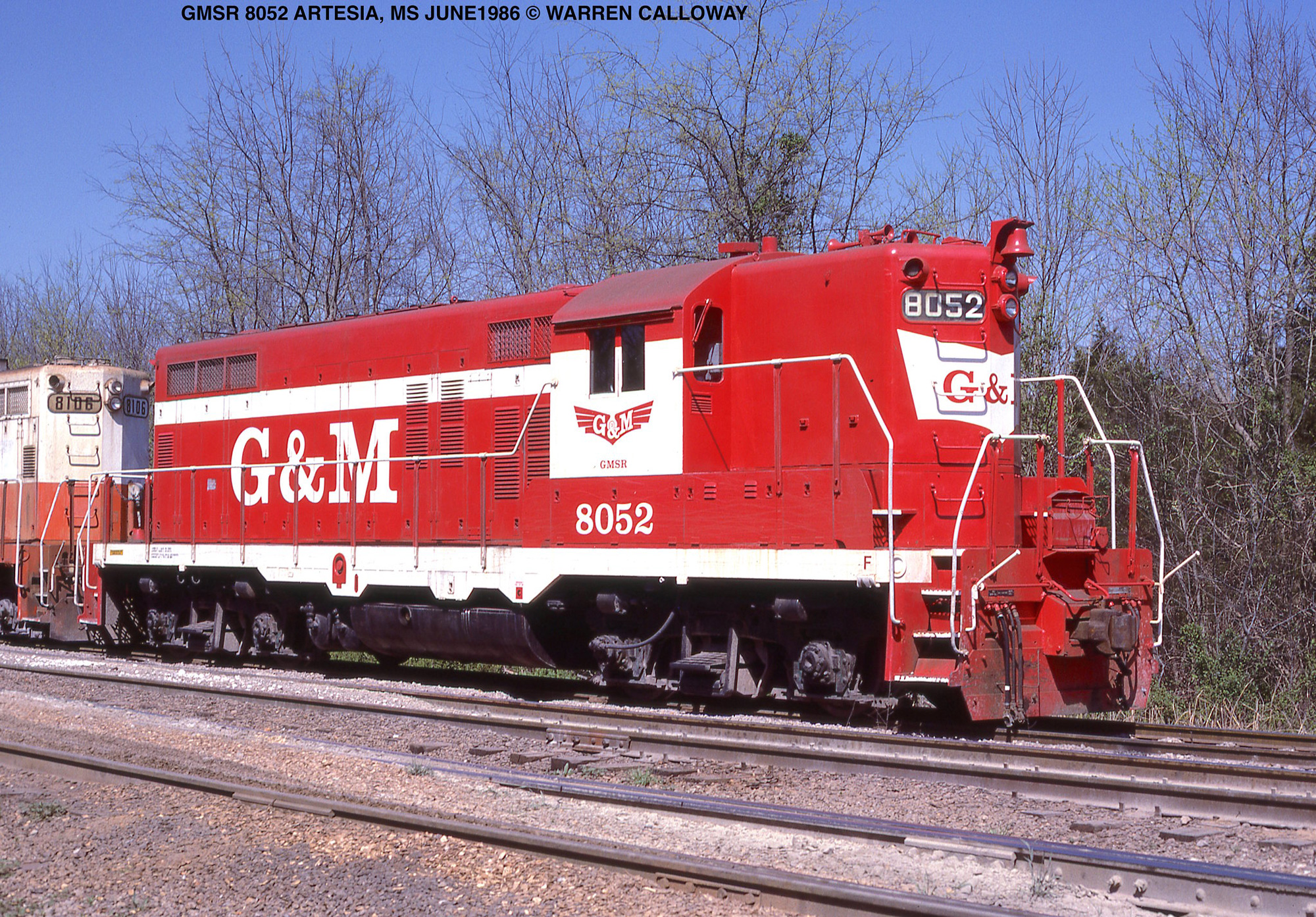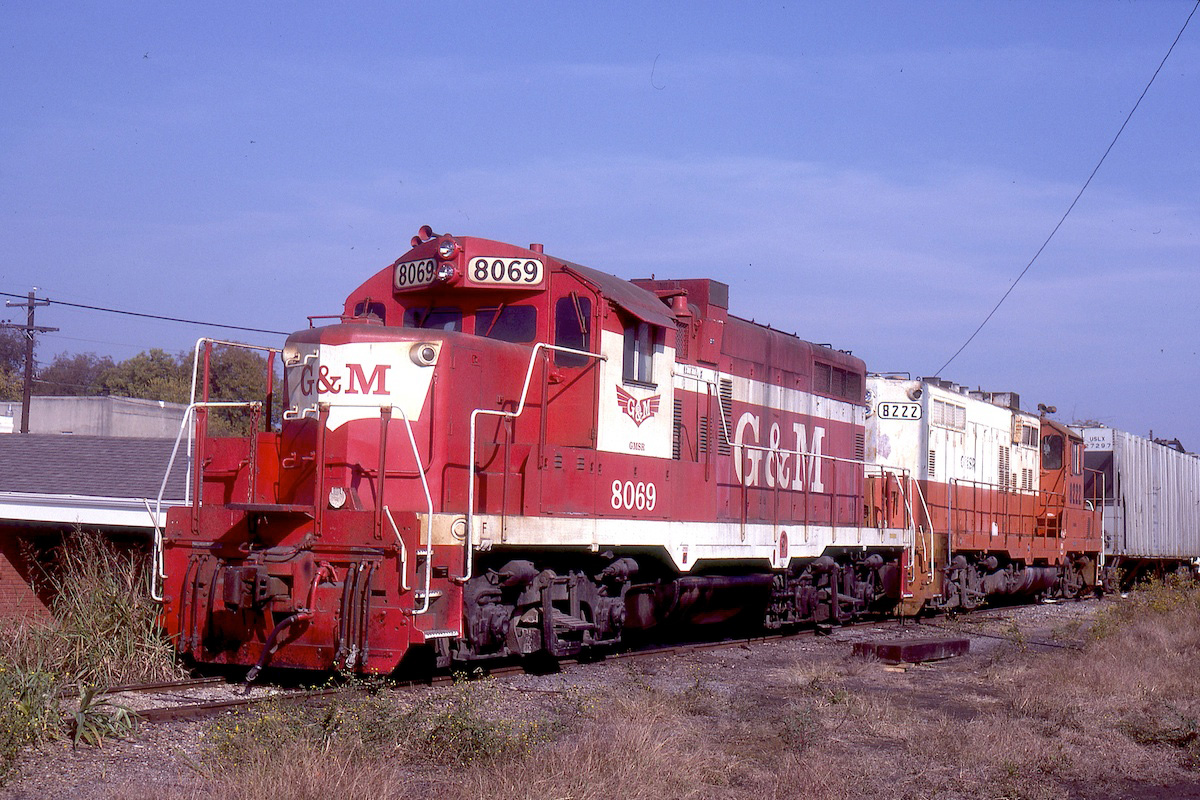Gulf & Mississippi Railroad: Route, Roster, History
Published: November 23, 2024
By: Adam Burns
The Gulf and Mississippi Railroad (GMSR) epitomized the short line era that emerged in the wake of the 1980 Staggers Rail Act. Formed in 1985, GMSR was part of a broader trend of rail spinoffs and line acquisitions that reshaped the rail landscape.
The railroad - the first regional ever created in the U.S. - was one of Illinois Central Gulf's four major spinoffs (MidSouth Rail Corporation in 1986; Chicago, Central & Pacific in 1985; and Chicago, Missouri & Western in 1987) in an effort to return to profitability.
In its relatively short lifespan, the regional navigated the challenges of operating in a competitive and often unforgiving industry, particularly during the 1980s as railroads attempted to regain their footing following decades of crushing regulation.
 Gulf & Mississippi GP10 #8052 is seen here in service at Artesia, Mississippi in June, 1986. Warren Calloway photo.
Gulf & Mississippi GP10 #8052 is seen here in service at Artesia, Mississippi in June, 1986. Warren Calloway photo.The inception of GMSR was steeped in the post-Staggers Act period, which allowed major railroads to streamline operations and divest surplus lines. This deregulation granted railway companies greater flexibility with pricing, services, and route management, spurring the divestiture of underperforming or geographically isolated routes.
GMSR's formation was pivoted on acquiring a collection of former Gulf, Mobile & Ohio (GM&O) routes, which themselves had become vestiges following the GM&O's merger with the Illinois Central to form the 9500-mile Illinois Central Gulf (ICG) in 1972.
The strategic layout of GMSR incorporated key stretches of track across Mississippi and Alabama with segments even reaching into southwestern Tennessee at Middleton. Altogether the railroad operated 713 miles.
GMSR's geographic footprint placed it in competition with several larger, more established rail systems, including the ICG, Burlington Northern, and Norfolk Southern.
A critical aspect of the GMSR was its heritage of infrastructure challenges. Much of the track it inherited was in poor condition, reflecting years of deferred maintenance and underinvestment.
This made operations cumbersome and hampered GMSR's ability to market its services effectively. With rail infrastructure central to efficient servic, the deteriorating state of the tracks necessitated considerable capital for upgrades — a sum that the fledgling system did not have.
Compounding these challenges was the regional economic backdrop. The GMSR served areas with a strong reliance on industries like forestry and agriculture. The commodity mix meant that its freight services primarily transported forest products, paper, pulpwood, agriculture, chemicals and other raw materials.
While these goods were pivotal to the local economies and provided GMSR with a steady (if modest) stream of revenue, they were also susceptible to shifts in industrial demands and competitive pressures from trucking.
The operational philosophy of GMSR espoused flexibility and customer service, embracing the regional model's advantages of being small enough to provide personalized service but robust enough to service key regional industries.
Despite the many challenges, to rebuild business lost during the ICG era, GMSR established four distinct operational districts:
1. *Meridian District*: This spans from Mobile, Alabama, traveling north through Meridian to Corinth, Mississippi, along what was once the mainline of the Mobile & Ohio, later GM&O.
2. *Louisville District*: Extending from Laurel, Mississippi, to Aberdeen, this district traces the former mainline of the Gulf, Mobile & Northern (GM&N), stretching from Laurel to Ackerman, and includes a segment of the former IC between Ackerman and Aberdeen.
3. *New Albany District*: Covering the area from Woodland, Mississippi, to Middleton, Tennessee, this district follows the former mainline of the GM&N.
4. *Tuscaloosa District*: Running from Artesia, Mississippi, to Tuscaloosa, Alabama, this follows the path of the former M&O main line.
 A chopnose Gulf & Mississippi GP10, #8069, was photographed here at Artesia, Mississippi in the fall of 1986. Warren Calloway photo.
A chopnose Gulf & Mississippi GP10, #8069, was photographed here at Artesia, Mississippi in the fall of 1986. Warren Calloway photo.Decline and Sale
By 1988, GMSR was facing the possibilty of bankruptcy. In April of that year, MidSouth Rail - a much more successful spinoff - stepped in and acquiring the ailing property to form a new subsidiary, SouthRail Corporation. This merger connected GMSR’s traffic to MidSouth’s system at Newton and Meridian, integrating it into MidSouth's strategy to develop the profitable east-west "Meridian Speedway."
Eventually, MidSouth and SouthRail were bought by Kansas City Southern in 1994. Today, KCS is part of the much larger Canadian Pacific-Kansas City (CPKC). Despite this, much of old GMSR's original trackage is still operational, with many segments now managed by new shortline operators:
- **Alabama Southern Railroad**: Managed by WATCO, this shortline operates the former M&O mainline from Columbus, MS, to Brookwood, AL.
- **Meridian Southern Railway**: An independent shortline running over the former M&O mainline between Meridian and Waynesboro, MS. The stretch from Waynesboro to Mobile has been abandoned.
- **Mississippi Southern Railroad**: Another WATCO shortline handling the former GM&N mainline from Ackerman to Bay Springs, MS, with the portion from Bay Springs to Laurel abandoned.
- **Ripley & New Albany Railroad**: A Pioneer Lines shortline running on the former GM&N mainline from New Albany to Ripley, with the section from Ripley to Middleton, Tennessee (out of service).
Kansas City Southern continues to operate the remaining portion of the former M&O mainline between Meridian and Corinth through Artesia. Lastly, part of the property is now a trail, including 44 miles of the former GM&N between Houston to New Albany, Mississippi which is now part of the Tanglefoot Trail.
Diesel Roster
| Road Number | Heritage | Model Type | Serial Number | Midsouth Rail Number | Disposition |
|---|---|---|---|---|---|
| 8009 | ICG | GP10 | 18806 | 1058 | Acquired by Independent Locomotive Service (#1001). |
| 8025 | ICG | GP10 | 18822 | 1079 | Scrapped |
| 8034 | ICG | GP10 | 18831 | 1056 | - |
| 8051 | ICG | GP10 | 19971 | 1077 | Acquired by Rail Switching Service (#5077). |
| 8052 | ICG | GP10 | 19772 | 1067 | Acquired by Kansas City Southern (#1868). |
| 8069 | ICG | GP10 | 20148 | 1069 | Acquired by Kansas City Southern (#1869). |
| 8082 | ICG | GP10 | 20161 | 1052 | Acquired by Rail Switching Service (#1052). |
| 8100 | ICG | GP10 | 20179 | 1078 | - |
| 8106 | ICG | GP10 | 20285 | 1051 | Acquired by Rail Switching Service (#1051). |
| 8115 | ICG | GP10 | 20294 | 1064 | Acquired by OmniTRAX as Carlton Trail Railway #1064. |
| 8133 | ICG | GP10 | 20771 | 1061 | Acquired by Indiana Boxcar (#1061). |
| 8148 | ICG | GP10 | 20786 | 1065 | Acquired by Ohio Central (#707), then as Everett Railroad #707. |
| 8167 | ICG | GP10 | 20805 | 1073 | - |
| 8187 | ICG | GP10 | 20825 | 1068 | Sold to the Panama Canal (#1855). |
| 8191 | ICG | GP10 | 22276 | 1057 | - |
| 8193 | ICG | GP10 | 22278 | 1062 | Acquired by Rail Switching Service (#1062). |
| 8195 | ICG | GP10 | 22280 | 1053 | Acquired by Railroad Power Leasing (#2405). |
| 8197 | ICG | GP10 | 22282 | 1054 | Acquired by National Railway Equipment. |
| 8210 | ICG | GP10 | 22333 | 1055 | Acquired by Independent Locomotive Service (#1004). |
| 8212 | ICG | GP10 | 22335 | 1063 | Acquired by National Railway Equipment. |
| 8215 | ICG | GP10 | 22338 | 1072 | Scrapped |
| 8222 | ICG | GP10 | 22287 | 1083 | Sold to Bloomer Shippers Connecting as #7505. |
| 8223 | ICG | GP10 | 22288 | 1082 | Acquired by National Railway Equipment. |
| 8224 | ICG | GP10 | 22289 | 1080 | Acquired by Joseph Transportation (#1080); later wrecked. |
| 8225 | ICG | GP10 | 22290 | 1074 | Sold to Southern Railway of British Columbia (#2). |
| 8226 | ICG | GP10 | 22291 | 1075 | Acquired by Independent Locomotive Service (#1002) |
| 8227 | ICG | GP10 | 22292 | 1066 | Preserved at the Waynoka Historical Society as Hudson Bay Railway #2511. |
| 8228 | ICG | GP10 | 22293 | 1071 | Sold to Ohio Central (#706). |
| 8230 | ICG | GP10 | 22295 | 1081 | Sold to Rail Switching Service (#1081). |
| 8235 | ICG | GP10 | 22300 | 1070 | Sold to Utah Railway (#1070). |
| 8236 | ICG | GP10 | 22301 | 1085 | Sold to Rail Switching Service (#1085). |
| 8247 | ICG | GP10 | 22312 | 1060 | Sold to Grainbelt Corporation/Farmrail (#2404). |
| 8248 | ICG | GP10 | 22313 | 1084 | - |
| 8256 | ICG | GP10 | 22321 | 1059 | Sold to Southern Railway of British Columbia (#3). |
| 8266 | ICG | GP10 | 17732 | 1076 | Sold to Buckingham Branch Railroad (#11). |
| 1775 | BN | GP9 | 20845 | 9006 | Scrapped |
| 6417 | BN | SD45 | 33036 | - | Preserved at the Lake Superior Railroad Museum. |
| 6536 | BN | SD45 | 37144 | - | Sold to Helm Leasing (#6507). |
| 6554 | BN | SD45 | 5794-12 | - | Sold to Wisconsin Central (#6554). |
| 6559 | BN | SD45 | 5794-17 | - | Sold to Wisconsin Central (#6559). |
| 6572 | BN | SD45 | 38368 | - | Sold to Wisconsin Central (#6572). |
| 6655 | BN | SD45 | 33016 | - | Sold to Wisconsin Central (#6655). |
| 6660 | BN | SD45 | 33022 | - | Sold to Wisconsin Central (#6497). |
| 7760 | Conrail | GP38 | 35389 | - | Sold to Bay Line Railroad (#502). |
| 7781 | Conrail | GP38 | 35410 | - | Sold to Bay Line Railroad (#503). |
| 7790 | Conrail | GP38 | 35419 | - | Sold to Bay Line Railroad (#504). |
| 7792 | Conrail | GP38 | 35421 | - | Sold to Bay Line Railroad (#505). |
| 7811 | Conrail | GP38 | 35440 | - | Sold to Bay Line Railroad (#506). |
| 7819 | Conrail | GP38 | 35448 | - | Sold to Bay Line Railroad (#507). |
 A trio of Gulf & Mississippi GP10s, led by #8228, has a string of pulpwood at Okolona, Mississippi in the spring of 1986. Warren Calloway photo.
A trio of Gulf & Mississippi GP10s, led by #8228, has a string of pulpwood at Okolona, Mississippi in the spring of 1986. Warren Calloway photo.Legacy
In reflecting on the history of the Gulf and Mississippi Railroad, we also perceive a microcosm of the broader regional railroad phenomenon. GMSR's story offers instructive insights into the variables that govern the lifecycle of such enterprises.
From its daring birth in the deregulation's early years to its eventual dissolution, GMSR underscores persistent themes in railroad history: adaptability in operations, the relentless chase for financial viability, and the interdependencies within the U.S. rail matrix.
For enthusiasts of railroad history, the story of GMSR is a compelling narrative of resilience, illustrating the critical influence of infrastructure and capital in determining the success or failure of railroads. As part of the tapestry of American rail history, GMSR remains a testament to the ebbs and flows of industrial evolution and an enduring lesson on the complexities faced by regional rail operators.
GMSR's journey also invites us to evaluate the lasting legacy of deregulation on the U.S. railway system. The post-Staggers era turned the tide for efficiency and innovation, but it also posed stark challenges for smaller players who struggled without deep pockets and large customer bases. Eating into the market shares of larger competitors required more than determination; it required strategic foresight and a keen sense of adaptability.
Recent Articles
-
New York - Murder Mystery - Dinner Train Rides
Dec 13, 25 10:30 AM
New York State, renowned for its vibrant cities and verdant countryside, offers a plethora of activities for locals and tourists alike, including murder mystery train rides! -
Pennsylvania - Murder Mystery - Dinner Train Rides
Dec 13, 25 10:25 AM
Pennsylvania, steeped in history and industrial heritage, offers a prime setting for a unique blend of dining and drama: the murder mystery dinner train ride. -
Ohio - Murder Mystery - Dinner Train Rides
Dec 13, 25 10:14 AM
The murder mystery dinner train rides in Ohio provide an immersive experience that combines fine dining, an engaging narrative, and the beauty of Ohio's landscapes.



